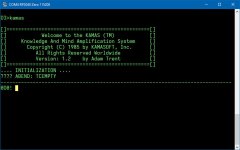seaken
Veteran Member
I'm not sure I can offer anything better than what has already been mentioned. My first thought was that I can't think of any best "starter" CP/M systems. CP/M was my first operating system and I inherited it with my North Star Advantage. I had to learn it so I could use it for writing contracts and printing them to paper on a serial attached Smith Corona daisy wheel printer. I had no money for buying a new computer at the time so I learned to use the Advantage and CP/M.
But that was 35 years ago. Back then CP/M was still supported. I learned to connect the Advantage to the phone line and dialed up bulletin boards and got lots of help. I even upgraded the machine with a hard drive and the Z-system. These days, you'll have to be pretty technical to get started with CP/M on any actual old hardware. If you are very handy with repairing hardware then I concur with some of the other comments. Your idea about a Kaypro seems to me to be a good idea, or an Apple IIe or C128. There is a lot more support for those machines than something like the Advantage or some other old proprietary equipment. But if you are a hardware guy then one of those old proprietary machines could be a lot of fun.
Seaken
But that was 35 years ago. Back then CP/M was still supported. I learned to connect the Advantage to the phone line and dialed up bulletin boards and got lots of help. I even upgraded the machine with a hard drive and the Z-system. These days, you'll have to be pretty technical to get started with CP/M on any actual old hardware. If you are very handy with repairing hardware then I concur with some of the other comments. Your idea about a Kaypro seems to me to be a good idea, or an Apple IIe or C128. There is a lot more support for those machines than something like the Advantage or some other old proprietary equipment. But if you are a hardware guy then one of those old proprietary machines could be a lot of fun.
Seaken




